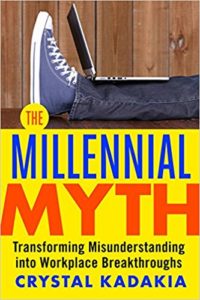Guest Post by Crystal Kadakia
I’m really excited to introduce you to a new Berrett-Koehler author, Crystal Kadakia, who is launching her first book, The Millennial Myth, this week. Crystal’s book is a refreshing take on the current media hype surrounding this now largest segment of today’s workplace. Her message resonates deeply for me given my research last year into generational differences—which, as it turned out, pointed instead to overwhelming similarities Millennials, GenXers and Baby Boomers all share.
Here’s a brief article from Crystal that will introduce you to her thoughtful themes and compelling style. I thoroughly enjoyed The Millennial Myth and believe it’s essential reading for leaders everywhere.
O ne of the biggest myths today, especially with regards to the millennial generation, is that team building is as simple as creating a fun, collegiate environment through changes like installing ping pong tables, offering free food, and hosting Friday happy hours. That’s what they are used to and are asking for, right?
ne of the biggest myths today, especially with regards to the millennial generation, is that team building is as simple as creating a fun, collegiate environment through changes like installing ping pong tables, offering free food, and hosting Friday happy hours. That’s what they are used to and are asking for, right?
Much more lies beneath the surface, like many millennial beliefs. Millennial workplace behavior, according to my research over the past five years, is a reflection of the digital world they grew up in. This approach disproves many millennial myths, and it provides insight into cross-generational workplace needs for a digital world. For team building, the need goes far beyond fun environments.
Team building is of much complexity and importance. Employees more commonly work from home, either part- or full-time. The work environment is more diverse and global. Workers do not work under the same assumptions of what normal looks like, acceptable behavior and communication using the same styles. And yet, the challenges of the job are more complex and fast paced, requiring more responsive and intuitive connections with our teammates. For an effective workplace that creates community and retains top talent in today’s virtual, diverse world, team building requires intentional design.
On example is from Team Concepts, a 22-year-old company founded by Dan Lyons, an Olympic rowing athlete. They have perfected a timeless, powerful approach to team building – using the coordinated physical movement of rowing to create intuitive bonds between teammates. While team building events often happen outdoors (like obstacle courses and trust falls we all know and love!), rowing is an inherently interdependent sport; one in which the participants must experience “flow” as a high-performing team.
In the day-long workshop known as Team Champion, a team is led through a series of activities starting with creating team missions, learning the basics of rowing, and getting on the water. As an enthusiastic observer, it was amazing to see how much the teams achieved in a short time. Everyone learned how to row, they were able to function together as a high performing team, and compete in a race at the end.
Some of the modern challenges I’ve been researching include an increased need and expectation to navigate a diverse world, not only by embracing differences, but genuinely respecting individuality while creating unity. Another challenge is the screen time Millennials and Gen Z engage in and the consequences for communication, motivation, and relationship building. The physical, intuitive interdependence demonstrated by rowing as a teambuilding approach helps overcome these challenges.
Challenge 1: Diversity
We have been working hard to understand what diversity and inclusion means. The needs are to create unity, and respect and understand differences. Primarily, we resort to discussion and meetings as default. While these discussions are important, we often need more to move to relationship building. In addition, diversity initiatives can unintentionally create divisions through segmentation.
By using rowing to build team bonds, we put the focus on something common to all humans – physical activity, which intuitively brings us together while inherently respecting our individuality. Team Concepts asserts that everyone wants to feel valued, and teaches the importance of empowering individuals within team synergy. This aligns well with the concept I discuss in my new book, The Millennial Myth, in which diversity and inclusion initiatives should start at the level of common topic, such as gender, then bring to life and support individual perspectives.
Challenge 2: Millennials, Gen Z, and Relationship Building
Stephen, a 25-year-old rowing coach and fellow millennial has seen a drastic shift in behavior with the next generation (Gen Z). While millennials remember a world without internet, Gen Z has no recollection of such a time. When Stephen comes face-to-face with communication and relationship building, he observes that video games are a large influence on the middle school kids he leads. While Stephen remembers staying up chatting with teammates, playing group games on the bus, and building relationships, Gen Z is often playing games on their own. What we are seeing in middle school kids represents an important signal to corporate: we need to intentionally build in physical, face-to-face, visceral experiences to create relationship-building skills.
Often, we think that to be “Millennial-friendly” or to keep up with our fast-paced world, we need to be high-tech and digital savvy. Our research on modern learning tells us differently. What we really need is to be purposeful, especially in the case of soft skills like team building, communicating, and diversity and inclusion. Millennials prefer face-to-face training, but for Gen Z, face-to-face learning is no longer a skill we can assume will be present at the same degree as in the past.
Just because virtual tools like social networks exist, we cannot replace or short cut in-depth training. We must concentrate on the goal we’d like to achieve, and consider the ROI of face-to-face, immersive experiences. For team building in the digital age, we need to keep a balance between face-to-face and virtual activities, not strive for 100% virtual.
This is just one of the many myths surrounding millennials and the modern workplace. What other millennial myths do you think are creating misleading strategy? Consider phrases often used to describe millennials like lazy, entitled, and disloyal. For more resources to transform these millennial myths and more into workplace breakthroughs, check out The Millennial Myth.
Crystal Kadakia is a two-time TEDx speaker and the founder of Invati Consulting, a leading firm that helps organizations modernize culture to attract, engage, and retain today’s digitally enabled workforce.



The Millenial Myth sounds like a great book to read about team building strategies. As I have gotten older and getting to know new people I have definitely learned that team building games play an important factor when working with co workers. I love the modern day challenges that you pointed out because sometimes we forget those little key factors of building a team. The Millennial Myth sounds like a great behavioral type of book that allows you to dive into the roots of team building.